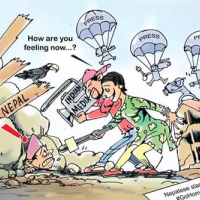Indian Media Faces Backlash in Nepal for Earthquake Coverage
 Cartoon depicting Indian journalists reporting in Nepal (photo: Twitter)
Cartoon depicting Indian journalists reporting in Nepal (photo: Twitter)
The Indian government’s prompt aid and rescue operations may have been praised in Nepal, but the Indian media is being criticized there for its “insensitive” coverage of the April 25 earthquake. #GoHomeIndianMedia is reportedly the top trending Twitter hashtag in Nepal, with complaints that the Indian media was treating the disaster as a “public relations exercise” for the Indian government.
For the Nepalese trying to rebuild their lives after the 7.9-magnitude earthquake that killed over 7,200 people, the “relentless and aggressive” coverage by the Indian media has not gone down well.
“ ... Media humiliated poor Nepal in order to take credit & cheap publicity in the hour of crisis. Sad,” said one tweet.
In a blog published on CNN, Sunita Shakya of Nepali origin writes, “Your media and media personnel are acting like they are shooting some kind of family serials.”
“If your media person can reach to the places where the relief supplies have not reached, at this time of crisis can’t they take a first-aid kit or some food supplies with them as well?” she asked.
Shakya also goes on to describe a couple of instances where the reporter did not do enough to help the injured person.
India was the first country to rush aid to Nepal within hours of the earthquake. Besides rescue teams and tons of equipment, medical aid, food, water and blankets, Indian military helicopters and planes also flew in 23 media personnel to Nepal.
While India’s rescue effort has been praised, the media’s relentless coverage of the tragedy has hurt the Nepalese.
More than 128,000 tweets on Sunday complained about and debated the Indian media’s coverage of Nepal’s worst quake in 80 years that has left hundreds of thousands homeless.
Some tweets said Nepal is a sovereign country and not a “satellite state.”
Many Nepalese complained that the Indian media was only highlighting the plight of Indians in Nepal and of the rescue efforts by the Indian military and the National Disaster Response Force (NDRF).
Twitter users accused the Indian journalists of being insensitive to survivors, often asking them irrelevant questions such as "How are you feeling?".
Part of the problem is that Indian TV new channels are readily available across Nepal, so these are facing more scrutiny than other foreign media.
According to Kunda Dixit, editor of Nepali Times, many foreign journalists who have come to Nepal are highlighting the rescue efforts of their own countries, but few Nepalese see their coverage since only Indian TV channels are available.
"For every negative tweet, there are 10 positive reactions about India's efforts in Nepal. We shouldn't read much into it," Dixit told the Hindustan Times.
- Karan Singh
To Learn More:
Why is Indian media facing a backlash in Nepal? (by Soutik Biswas, BBC News)
Nepal earthquake: Indian media faces complaints about 'insensitivity' (by Utpal Parashar, Hindustan Times)
Quake-hit vent their ire on Indian media (PTI)
Twitterati in Nepal slam Indian media for its coverage of earthquake disaster (PTI)
- Top Stories
- Controversies
- Where is the Money Going?
- India and the World
- Appointments and Resignations
- Unusual News
- Latest News
- India College Chain’s Expansion into U.S. Draws Opposition from Massachusetts Officials over Quality of Education
- Milk Shortages in India Tied to Release of New Movies Featuring Nation’s Favorite Stars
- Confusion Swirls around Kashmir Newspaper Ban in Wake of Violent Street Protests
- Polio-Free for 5 Years, India Launches Vaccine Drive after Polio Strain Discovery
- New Aviation Policy Could Increase Service, Lower Ticket Prices






Comments